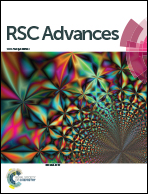Self-powered, ultraviolet-visible perovskite photodetector based on TiO2 nanorods
Abstract
A self-powered, ultraviolet-visible perovskite photodetector based on TiO2 nanorods/CH3NH3PbI3 heterojunction was reported. We found that the device showed good photovoltaic properties with a short-circuit current density of 17.83 mA cm−2, an open-circuit voltage of 0.76 V and a fill factor of 51.34%, leading to a PCE of 6.95%. Based on the wide band gap and the perovskite supporting part of the TiO2 nanorods, the device showed good ultraviolet-visible photo-response characteristics with the responsivity at zero bias reaching ∼0.26 and 0.85 A W−1 at 364 and 494 nm, respectively. These results present potential applications of TiO2/perovskite photodetectors in ultraviolet and visible regions.


 Please wait while we load your content...
Please wait while we load your content...